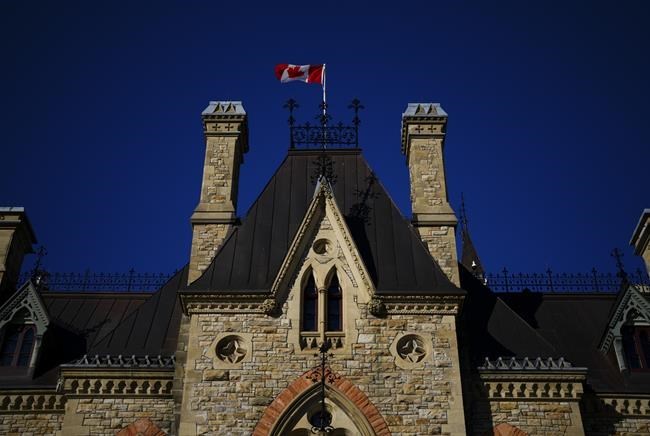OTTAWA — Finance Minister Chrystia Freeland delivered a federal budget Tuesday that keeps the deficit capped at $40 billion, thanks to higher-than-expected government revenues and new taxes that largely offset billions in new spending.
Freeland presented the federal budget in the House of Commons in the afternoon, which pledges $53 billion in new spending that she says is focused on economic justice for younger generations.
"We are moving with purpose to help build more homes, faster. We are making life cost less. We are driving the kind of economic growth that will ensure every generation of Canadians can reach their full potential," said Freeland in her opening remarks in the House of Commons.
The Liberal government plans to pay for most of its new spending initiatives with higher taxes on the wealthiest Canadians and businesses, and from stronger-than-expected government revenues.
The budget proposes to increase the capital gains inclusion rate, which refers to the taxable share of profit made on the sale of assets.
The taxable portion of capital gains above $250,000 would rise from half to two-thirds, which the federal government says will only affect 0.1 per cent of Canadians and raise nearly $20 billion in revenue over five years.
All capital gains realized by corporations and trusts will face the two-thirds inclusion rate.
"I know there will be many voices raised in protest. No one likes paying more tax, even — or perhaps particularly — those who can afford it the most," said Freeland.
"But before they complain too bitterly, I would like Canada's one per cent — Canada's 0.1 per cent — to consider this: What kind of Canada do you want to live in?"
Dan Kelly, president of the Canadian Federation of Independent Business, said an early assessment of the tax changes to capital gains will see most small businesses better off.
That's because the government increased the lifetime capital gains exemption from around $1 million to $1.25 million, which means Canadians can exempt capital gains up to that amount on the sale of small business shares and farming and fishing property.
The government is also proposing the Canadian Entrepreneurs' Incentive, which will reduce the inclusion rate to a third on a lifetime maximum of $2 million in eligible capital gains.
"But the capital gains inclusion rate increase to 66.7 per cent will create many net losers, including owners of medium-sized businesses," Kelly said in a statement.
The Liberal government is pointing out that in other countries, including the United States, businesses have to pay corporate taxes on all capital gains.
James Orlando, TD's director of economics, said federal spending is speeding up but remains below the government's self-imposed "speed limit."
"We're looking at a deficit profile that is going to be wider than what we saw just a few months ago. And so that means that you're going to have greater spending, greater debt burden," Orlando said in an interview.
"But due to the fact that common growth has improved, you still have the government flying under their fiscal anchors."
In the lead-up to the budget, Freeland promised that the government would abide by the fiscal guardrails it promised in the fall, including keeping the deficit from rising above $40.1 billion.
The fall economic statement also set the goal of keeping deficits below one per cent of GDP beginning in 2026-27 and lowering the debt-to-GDP ratio in 2024-25 relative to the projection.
While the deficit for the 2023-24 fiscal year remained flat at $40 billion, it came in higher than previously forecast for the rest of the projection horizon.
Still, the deficit, deficit-to-GDP ratio and debt-to GDP ratio are all projected to fall every year until 2028-29.
Federal finances are also benefiting from a stronger economy and higher-than-expected income tax revenues, which also helped the government pay for new measures without blowing through their promised fiscal guardrails.
The spending plan from Ottawa coincided with the latest consumer price index report.
Canada's annual inflation rate ticked up to 2.9 per cent in March, while measures of core inflation cooled, reinforcing the possibility of a June rate for the Bank of Canada.
Governor Tiff Macklem applauded the federal government's new fiscal anchors unveiled in the fall and has called for fiscal policy to row in the same direction as monetary policy.
But Orlando said increasing deficits don't make the central bank's job of fighting inflation easier.
"I would argue that ... having greater deficits is inflationary for Canada. And so it's not helping the Bank of Canada in any way with respect to bringing down inflation," he said.
The federal deficit is projected to be $39.8 billion for the 2024-25 fiscal year, which is above the fall's projection of $38.4 billion.
While much of the federal budget's focus was on affordability and housing, the Liberals also earmarked some money for initiatives aimed at boosting the economy's productivity.
That includes billions to expand the country's artificial intelligence capacity and boost research support.
Orlando said whether these measures help spur more productivity through technology development won't be known until a few years down the road.
"At the same time, it's very easy to argue that extra taxes disincentivizes investment in this country, and what we need in this country is more investment."
This report by The Canadian Press was first published April 16, 2024.
Nojoud Al Mallees, The Canadian Press




